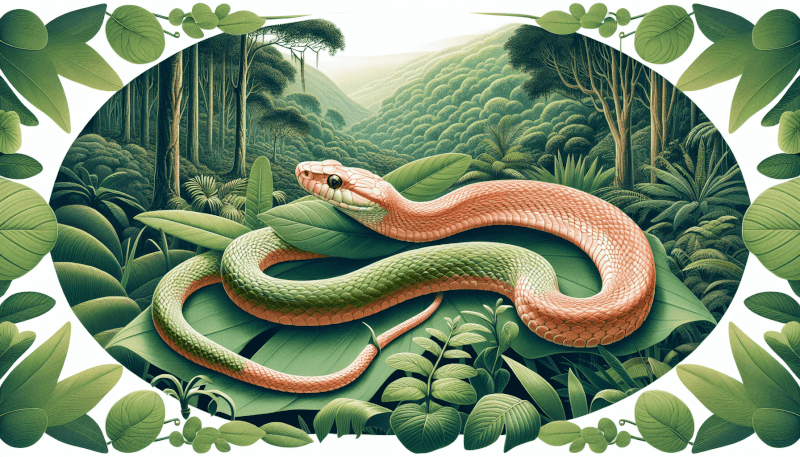Imagine stumbling upon a creature so enchanting and captivating, its presence seems almost otherworldly. Such is the case with the Peach Colored Snake, a fascinating reptile that boasts an exquisite hue reminiscent of the soft, delicate tones of a ripe peach. This mysterious serpent, with its strikingly beautiful coloration, is a sight to behold, leaving onlookers spellbound in awe. Delve into the world of this extraordinary snake as we explore its origins, characteristics, and the wonder it brings to the diverse realm of the animal kingdom.
Appearance of Peach Colored Snakes
Peach colored snakes, as their name suggests, exhibit a unique and captivating hue that resembles the soft, warm tones of a ripe peach. Their coloration is a result of specialized pigments found in their scales, which give them their distinct peachy hue. They often have a subtle gradient, with varying shades of peach from head to tail. The color intensity can vary among individuals, with some snakes having a more vibrant peach coloration than others.
In terms of size and shape, peach colored snakes display a range of diversity. Some species can grow to impressive lengths, reaching up to 8 feet, while others are more petite, measuring around 2-3 feet. The body shape of peach colored snakes is typically slender, allowing them to navigate through various environments with ease. This streamlined physique enables them to gracefully glide across the ground, making them excellent climbers and swimmers.
When it comes to pattern and texture, peach colored snakes often possess a smooth and glossy appearance, with their scales overlapping neatly. Some species may exhibit intricate patterns, such as thin stripes or speckles, adding further to their fascinating appearance. Despite their elegant markings, they blend effortlessly into their surroundings, using their coloration and patterns to camouflage and remain inconspicuous to potential predators and prey.
Habitat and Distribution
Peach colored snakes have a preference for certain habitats that provide them with the optimal conditions for survival. They are most commonly found in areas with temperate or tropical climates, where they can thrive in a variety of environments. These snakes can be discovered in both terrestrial and arboreal habitats, including forests, grasslands, and even semi-aquatic areas such as marshes and swamps. Their ability to adapt to different surroundings contributes to their widespread distribution.
The geographical distribution of peach colored snakes spans across various regions around the world. They are often found in North America, particularly in the southeastern United States. Additionally, they can be spotted in parts of Central and South America, Africa, and Asia. This wide distribution reflects their ability to adapt to diverse climates and ecosystems, making them a fascinating subject for biodiversity studies.
Within their natural environment, peach colored snakes play a crucial role in maintaining the balance of ecosystems. Their presence helps regulate populations of small mammals, reptiles, and amphibians, making them important predators in their respective habitats. By controlling the population of these organisms, peach colored snakes indirectly influence the overall stability and health of their ecosystems.

Species of Peach Colored Snakes
Numerous species of peach colored snakes exist, each with distinct characteristics and traits that set them apart. Identifying these different species can be challenging for the untrained eye, as they often share similar coloration. However, closer examination of their patterns and physical attributes can aid in species differentiation.
The characteristics and traits of peach colored snakes vary among species. Some have slender bodies and elongated heads, while others possess thicker bodies with a more triangular-shaped head. In terms of behavior, some species are more active during the day, while others are primarily nocturnal. Furthermore, their preferred diet may also differ, with some species feeding predominantly on small rodents, while others prefer insects or amphibians.
Peach colored snakes hold a significant place in the ecosystem due to their role as predators. They help control populations of small rodents, preventing their exponential growth and the subsequent disruption of the delicate balance within their habitats. This underscores the essential role these snakes play in maintaining the overall health and stability of ecosystems they inhabit.
Behavior and Diet
The behavioral patterns of peach colored snakes vary among species and can be influenced by factors such as climate and habitat. Some species are relatively docile and are known to exhibit calm and non-aggressive behavior when encountered. However, it is essential to exercise caution and respect when interacting with any snake, as they can become defensive if they feel threatened.
In terms of feeding habits, peach colored snakes display a diverse appetite. Their diet primarily consists of small mammals, such as mice and rats, but they may also consume other reptiles, amphibians, birds, and even insects. This varied diet ensures they can adapt to changes in their environment and maintain their energy levels.
As predators, peach colored snakes face threats from other animals that occupy higher trophic levels. Natural predators of peach colored snakes include larger snakes, birds of prey, and some mammals. However, their specialized coloration provides them with a level of protection, allowing them to blend into their surroundings and minimize the risk of predation.

Reproduction and Life Cycle
The mating behavior of peach colored snakes varies among species, with some engaging in courtship rituals and others partaking in combat dances to attract a mate. Once a suitable mate is found, the female undergoes gestation, during which she carries the developing offspring within her body. The duration of gestation can range from several weeks to a few months, depending on the species.
After the gestation period, female peach colored snakes lay eggs rather than giving birth to live young. The number of eggs laid can vary significantly, ranging from a few to over a dozen. These eggs are typically deposited in secure locations, such as burrows or concealed areas, to protect them from potential predators.
Upon hatching, the young snakes emerge from their eggs and enter the early stages of development. They are independent from birth and must navigate their environment to find suitable shelter and food. It is during this vulnerable stage that they face the highest risk of predation. As they grow and gain strength, they develop the characteristics and coloration that distinguish their species.
Interesting Facts about Peach Colored Snakes
Peach colored snakes possess several interesting features and adaptations that contribute to their unique nature. One remarkable fact about these snakes is their ability to blend into their surroundings seamlessly. Their peach coloration allows them to camouflage among foliage and vegetation, making it difficult for predators or prey to spot them.
In addition to their camouflage abilities, peach colored snakes also exhibit a range of other fascinating traits. Some species possess a specialized heat-sensing organ, known as a pit organ, located on their heads. This organ enables them to detect the body heat of potential prey, aiding in their hunting success. Another interesting fact is that peach colored snakes do not produce venom, relying instead on constriction to subdue their prey.
Human interactions with peach colored snakes are relatively limited. These snakes are generally shy and prefer to avoid confrontation, making them unlikely to pose a threat to humans unless directly provoked. However, it is always advisable to exercise caution and respect when encountering any snake to prevent unintended harm or stress to both the snake and human.
Conservation Status
The conservation status of peach colored snakes varies depending on the specific species and their geographical location. Some species may be relatively abundant, while others may face threats to their population due to various factors.
Threats to the population of peach colored snakes can arise from habitat destruction and fragmentation caused by human activities, such as deforestation and urbanization. These activities can disrupt their natural habitats, leading to a decline in population numbers. In some regions, peach colored snakes also face the threat of illegal collection for the pet trade, which can have detrimental effects on wild populations if not properly regulated.
Conservation efforts aimed at protecting peach colored snakes focus on preserving their natural habitats and raising awareness about the importance of these snakes within their ecosystems. Measures such as establishing protected areas and implementing regulations on collection and trade can significantly contribute to the preservation of these remarkable snakes.
Mythology and Cultural Significance
Peach colored snakes hold symbolism and cultural significance in various cultures around the world. In some cultures, these snakes are associated with transformation and renewal due to their ability to shed their skin. This process of shedding is often seen as a representation of personal growth and rejuvenation.
Folklore and beliefs surrounding peach colored snakes vary among different cultures. In some societies, they are considered omens of good fortune and prosperity, while in others, they are associated with wisdom and protection. Artistic representations of these snakes can be found in various artworks, such as paintings and sculptures, further highlighting their cultural significance.
Similarities to Other Snakes
When comparing peach colored snakes to other colors found in the snake world, it is evident that their soft peachy hue sets them apart. While other snakes may exhibit similar shades, the distinctive peach coloration remains a unique feature of these snakes. The subtle gradient and variations in intensity contribute to their captivating appearance.
In terms of resemblances to other species, peach colored snakes may share physical characteristics with other snake families or genera, such as their slender bodies or triangular-shaped heads. However, their peach coloration remains a distinguishing factor that sets them apart from other snake species.
Differentiating factors between peach colored snakes and other species lie in their coloration, pattern, and habitat preferences. These factors allow experts to identify and classify these snakes accurately, distinguishing them from other snake species found in similar regions or with similar physical attributes.
Keeping Peach Colored Snakes as Pets
Keeping peach colored snakes as pets requires appropriate care and consideration to ensure their well-being. Proper enclosures are essential, providing adequate space, temperature gradients, and hiding spots to replicate their natural habitat conditions. It is important to research and understand the specific needs of the species before bringing one into your home.
Feeding and handling peach colored snakes should be done with caution and in adherence to ethical standards. Their diet consists mainly of small rodents, which can be obtained from reputable sources. Regular veterinary check-ups, a suitable feeding schedule, and a clean enclosure are vital to maintaining the health and happiness of these snakes.
Before deciding to own a peach colored snake as a pet, potential owners should consider various factors. These include their commitment to providing proper care, the resources required (both financial and time), and any local regulations or permits necessary to keep these snakes legally. Responsible ownership and education are key to ensuring the welfare of the snakes and maintaining the health of captive populations.
In conclusion, peach colored snakes are captivating creatures with their unique coloration, diverse habitats, and fascinating behaviors. Their presence in ecosystems contributes to the overall balance and health of their environments. Appreciating their beauty and understanding their importance in the natural world is crucial for their conservation and the preservation of their habitats. Whether encountered in the wild or kept as pets, these snakes continue to intrigue and inspire awe in those fortunate enough to witness their graceful presence.


